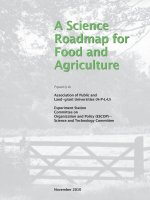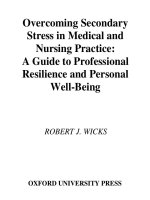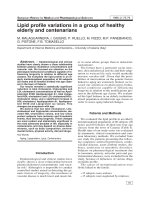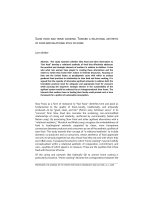Organic farming: A path to healthy food and environment
Bạn đang xem bản rút gọn của tài liệu. Xem và tải ngay bản đầy đủ của tài liệu tại đây (337.3 KB, 8 trang )
Int.J.Curr.Microbiol.App.Sci (2020) 9(3): 637-644
International Journal of Current Microbiology and Applied Sciences
ISSN: 2319-7706 Volume 9 Number 3 (2020)
Journal homepage:
Review Article
/>
Organic Farming: A Path to Healthy Food and Environment
P. P. Patel1* and D. D. Champaneri2
1
ASPEE College of Horticulture and Forestry, Navsari Agricultural University, Navsari,
Gujarat – 396450, India
2
Department of Vegetable Science, ASPEE College of Horticulture and Forestry, Navsari
Agricultural University, Navsari, Gujarat – 396450, India
*Corresponding author
ABSTRACT
Keywords
organic,
environment,
horticulture,
agriculture, soil
health, economics
Article Info
Accepted:
05 February 2020
Available Online:
10 March 2020
Conventional farming methods have significantly increased yields but in
recent times due to the increased awareness of people about health, there
has been increasing demand of organically grown foods. Organic farming
helps in maintaining soil health and thereby produce healthy and quality
food materials. This concern has prompted an expanding enthusiasm for
organic farming methods since they may diminish a portion of the negative
impacts of conventional farming on the earth. Different organic farming
methods have been used for many years to make agriculture and
horticulture practical while preserving soil, water, energy, and organic
assets. The future of agribusiness can be made increasingly economical and
naturally solid by embracing some traditional organic farming methods and
technologies.
defined as cultivation of crops without the use
of synthetic chemicals like agrochemicals and
use of compost manure, neem based products,
green compost and practice crop rotation to
grow the crops.
Introduction
In the recent times, various issues related to
health of human beings are debated which are
directly or indirectly linked to the heavy use
of synthetic agrochemicals in crop production
and their residual effect (Pimentel et al.,
2005). This has led to the increased awareness
in public about their health and organic
farming is again back into the practices which
was practiced before the invention of
agrochemicals and huge numbers of farmers
are moving towards the organic farming of
different crops. Organic farming can be
It is an integrated farming system that focuses
on sustainability, enhancement of soil flora
and fauna and thereby maintaining soil
fertility. Organic farming prohibits use of
synthetic pesticides, synthetic fertilizers,
antibiotics, growth hormones and genetically
modified organisms. It aims on providing
healthy food. To overcome the losses
637
Int.J.Curr.Microbiol.App.Sci (2020) 9(3): 637-644
confronted by conventional farming methods,
organic farming concept is now greatly
emphasized. Integrated pest management and
nutrient management by using more of
organic products can help in reducing the use
of synthetic chemicals and can make
environment healthy and sound. Government
of some countries like Sweden, Canada, etc.
have demonstrated that use of pesticides can
be greatly reduced without loss of yield and
quality (BANR/NRC 2003).
synthetic agrochemicals and reduce other
inputs to improve the environment and farm
business. The goal of organic farming is to
conserve the ecological processes, improve
nutrients intake and save water resources.
With ongoing concerns about nature and the
synthetic chemical substances utilized in food
production, and with the developing
accessibility of guaranteed certified organic
food production, the viewpoint for proceeding
with development of organic food production
is brilliant (Dimitri and Greene 2002).
Organic farming methods can eliminate use of
638
Int.J.Curr.Microbiol.App.Sci (2020) 9(3): 637-644
This paper focuses on the various findings of
research
to
investigate
soil
health,
environment and economics of organic
farming on different types of crops. Various
advantages and the need of organic farming in
present times has been analyzed and
presented.
All things considered, it is extremely hard to
separate soil fertility from production and
ecological parts of the system. Crop rotation
is the focal apparatus that coordinates the
maintenance and improvement of soil fertility
with various aspects of crop and livestock
production in natural systems. Supplemental
nutrients supply to crops relies upon the use
of legumes and vegetables to add nitrogen to
the soil in acceptable forms.
Soil Health Aspects
Growing research and evidences links
management of farms and land, soil health
and plant health yet connections among soil
health, food crop dietary and nutritional
quality, and human health with wellbeing are
less understood. Various examinations are
done so as to reveal insight into these
connections about organic farming and soil
health. Organic farming systems use carbonbased changes, differing crop revolutions, and
spread crops to build soil fertility.
Organic manures and farm waste are
deliberately figured out that how to reuse
supplements around the farm. The
management of soil organic matter, basically
using short term leys, guarantees great soil
structure and biological action, significant for
supplement supply, health and profitability of
the both- harvested crops and domesticated
animals. Carefully planned diverse rotations
helps in lessening the frequency of pests and
diseases and take into account cultural
methods and various techniques for weed
control. Because of the intricate interactions
between various components of a system,
fertility management in organic farming
depends on a long term coordinated approach.
These
practices
increase
biologically
accessible soil organic matter and helpful soil
microorganisms and invertebrate activities,
improve soil physical properties, diminish
disease potential and increase plant health and
leading to good growth and development of
plants. Ongoing researches proposes that
organically grown products contain more
significant levels of health promoting
phytochemicals, potentially connected to
more prominent plant stress, rhizosphere
microbial networks, and additionally lower
accessible nitrogen. Yet, the overlap in
different management practices among
different farming systems makes broad
generalizations
troublesome.
Besides,
ecological and crop species or potentially
cultivar interactions may apply more
grounded impacts than the management.
Organic farming heavily relies upon green
manuring and increasing the levels of organic
matter in the soil. The use of organic
materials has shown positive effects on the
various properties of the soil. Increasing the
levels of organic matter in the organic
farming methods can cause fluctuations in the
ion concentrations of soil and soil pH.
Supplements high in organic matter when
incorporated heavily in soil leads to increase
in the faunal population which are beneficial
to maintain the soil fertility.
Various researches shows that the farms on
which organic farming has been practiced
over years have higher levels of organic
matter, total nitrogen content, has high cation
exchange capacity. Also this soils have high
Complex connections exist between various
segments of the organic farm and the quantity
and quality of the end products rely upon the
working of the entire framework and systems.
639
Int.J.Curr.Microbiol.App.Sci (2020) 9(3): 637-644
extractable potassium, water content, pH,
polysaccharide content, enzyme levels and
good amount of microbial biomass.
Organically farmed based soil also has good
physical properties like more granular
structure, less hard and more friable. Research
proved that organic farmed based soils also
shows lesser amount of soil erosion due to
good soil structure which can be maintained
by different crop rotations. Organic farms
include green manure crop in its rotation and
had different tillage methods which provides
benefits against soil erosion. This indicates
that organic farming over long period has
greater benefits in maintaining soil tilth and
other soil properties.
and also increase the uptake of nutrients from
the soil as they can be easily available.
Organic matter provides better aeration in the
soil due to aggregate formation.
Nutrient cycling efficiencies can be greatly
balanced by using organic matter which can
be observed in organic farming. Organic
matter in the soil can help in storing of water
and thereby reducing the ill effects of drought
on plants.
Organic farming also helps to increase the
beneficial microbes in the soil and augment
them. Fungus, nematodes and other organism
are present in abundant quantity in organic
farming based soils. Parasitic fungus are
available in high amount which controls the
level of harmful fungus which hampers the
plant growth and productivity. But contrary to
this sometimes high level of harmful
organisms can also be observed. Mycorrhizal
fungi are very useful in organic farming as
they acts as natural fertilizers and helps in
increasing plant yield. It also contributes to
increase crop productivity and enhancing
ecosystem sustainaibility.
Lower amount of organic matter in the soil
leads to poor soil structure and it inhibit crop
rooting. Vegetable crops are mostly shallow
rooted crops and this affects the rooting of the
plants and thereby affecting the growth and
development of the plant. Organic matter in
the soil can help in even distribution of
nutrients and micronutrients can be easily
available. Organic materials in the soil binds
the particles and make good structure of soil
which helps in better activity of root system
640
Int.J.Curr.Microbiol.App.Sci (2020) 9(3): 637-644
conventional farming regarding more
extensive, worldwide effects. Direct energy
use, energy related emissions, and ozone
depleting greenhouse gases are higher for the
organic farming test. Direct water use and
business are lower for the organic farms.
Overall the emissions and other factors
impacting greenhouse effect are not too much
high in the organic farming systems.
Environment Aspects
Organic farming methods have been advanced
as, inter alia, diminishing the environmental
effects of agriculture. Organic farming
practices commonly have positive and
beneficial on the environment per unit of
zone, yet not really per product unit. Organic
farms in general have higher soil organic
substance and lower nutrient losses (nitrogen
draining, nitrous oxide emissions and alkali
emissions) per unit of field area. However,
alkali emissions, nitrogen leaching and
nitrous oxide emission per item unit are
higher from natural and organic farming.
Various comprehensive assessment tools are
required for describing overall environmental
impacts of different agriculture systems for
developing highly sustainable systems for
more production and less environmental
effects. Presently LCA (Life Cycle
Assessment) is being greatly utilized to
compare the environmental sustainability of
different farming methods and their products.
When LCA studies are performed for organic
farming methods it shows wide variation in
the results. More variation is observed in
resource efficiency of products from this
different methods of farming. The studies
shows that impacts on environment per area
of farmed land are usually less in organic
farming but when related to quantity
produced environmental effects are often
greater.
Organic farming had lower energy
requirements,
yet
higher
land
use,
eutrophication potential and fermentation
potential per product unit. Impacts that are
found to vary altogether between the systems
are soil organic matter content, nitrogen
leaching, nitrous oxide emissions per unit of
field area, energy use and land use. A large
portion of the examinations that thought about
biodiversity in organic cultivating exhibited
lower ecological effects. In organic farming,
the principle challenges are to improve the
nutrient management and increase yields.
Cropping patterns can influence the impact on
environment of farming systems. Mono
cropping which is essential in organic farming
certification is factor impacting the
environment of the organic farming.
Organic farming uses low agricultural inputs
and it results in low energy demand. Organic
farming can help in energy savings and
carbon sequestration when practiced on huge
scale. Also it provides number of important
environmental and social services like
improving and maintaining the soil quality,
increasing carbon sink, reducing the water
usage, preserving biodiversity, reducing the
use of harmful chemicals which guarantees
safe food to people.
The arrangement of food production system
causes environmental effects that range from
local through to worldwide in scale. Organic
farming, used here to mean farming practices
with a more prominent emphasis on long term
sustainability, is one general way to deal with
reduce these effects. While organic farming
might be contended to be better than
conventional cultivating based on local
impacts, it is indeed not clear how organic
farming
performs
comparative
with
Insect- pests and pathogens are the major
problems in growing food organically by
various organic farming methods. It can be
controlled by employing various crop rotation
641
Int.J.Curr.Microbiol.App.Sci (2020) 9(3): 637-644
techniques. Some pests can be controlled by
various parasitoids. Controlling of pests by
parasitoids in organic farming of tomato has
shown good results. Augmentation of various
biological fauna can help in destruction of
harmful pests and disease causing organisms.
results in higher biodiversity of flora and
fauna. With the increased organisms
biodiversity in the soil it can lead to increased
activity in soil which helps in soil health
management.
Various types of fauna helps in pollination
and increase the crop productivity.
Researches shows that when organic farming
is practiced in a proper and sustained way it
can avoid losses of species and increase the
landscape view of the surroundings.
Contamination of water with chemicals leads
to deterioration of environment and also
effects the human health. Contamination of
groundwater with various chemicals can also
be avoided in organic farming systems.
Use of agrochemicals which are harmful to
human health can be lowered by use of
parasitoids, entomopathogens, etc. In organic
farming systems oils and natural chemicals
are largely used which indirectly provides
good environmental effect. Neem based
products are widely used for controlling
various types of pests and diseases. Due to
this environmental impacts can be lessened as
lower usage of chemicals by which soil and
human health can be benefited.
Research showed that the population of
bumble bees are affected with context to the
landscape of the farms and its practices.
Higher homogeneity is observed in the
landscape of the organic farms with species
richness and its abundance which attracts the
bumble bees. Another factor affecting the
attraction of bees to organic farming
landscapes is number of different flowers and
abundance on the site.
Organic farming plays another role in
maintaining and harboring various floral and
faunal biodiversity. When organic farming is
practiced it maintains the species in an
environment. GMO ( Genetically modified
organisms ) are also not permitted in organic
farming systems as they disturb the habitat of
natural flora and fauna. The restricted use of
pesticides in the organic farming approach
642
Int.J.Curr.Microbiol.App.Sci (2020) 9(3): 637-644
Economics Aspects
References
Organic products are in huge demand
nowadays due to increased awareness about
health in public. Organic products comes at
higher prices due to increased cost of
cultivation in terms of money for producing
healthy foods. Planting materials, organic
manures, plant protection and other things
increase the cost of cultivation. Organic
technologies when used for organic farming
requires higher labour inputs. Yields can be
substantially reduced for major horticultural
crops in organic farming which decreases the
profit level of farmers. In organic farming,
weed competition is one major issue which
leads to increase in the cost of cultivation.
Arden-Clarke, C., and Hodges, R. D. (1988).
The
environmental
effects
of
conventional and organic/biological
farming systems. II. Soil ecology, soil
fertility and nutrient cycles. Biological
Agriculture & Horticulture, 5(3), 223287.
[BANR/NRC] Board on Agriculture and
Natural Resources, National Research
Council. 2003. Frontiers in Agricultural
Research: Food, Health, Environment,
and Communities.
Delate, K., Duffy, M., Chase, C., Holste, A.,
Friedrich, H., & Wantate, N. (2003). An
economic comparison of organic and
conventional grain crops in a long-term
agro ecological research (LTAR) site in
lowa. American Journal of Alternative
Agriculture, 18(2), 59-69.
Dimitri C, Greene C. 2002. Organic food
industry taps growing American market.
Agricultural Outlook (October): 4–7.
Gomiero, T., Paoletti, M. G., & Pimentel, D.
(2008). Energy and environmental
issues in organic and conventional
agriculture. Critical Reviews in Plant
Sciences, 27(4), 239-254.
Gomiero, T., Pimentel, D., & Paoletti, M. G.
(2011). Environmental impact of
different
agricultural
management
practices: conventional vs. organic
agriculture. Critical reviews in plant
sciences, 30(1-2), 95-124.
Hartmann, M., Frey, B., Mayer, J., Mäder, P.,
& Widmer, F. (2015). Distinct soil
microbial diversity under long-term
organic and conventional farming. The
ISME journal, 9(5), 1177.
Pimentel, D. (1993). Economics and
energetics of organic and conventional
farming. Journal of Agricultural and
Environmental Ethics, 6(1), 53-60.
Pimentel, D., Hepperly, P., Hanson, J., Seidel,
R., & Douds, D. (2005). Organic and
Organic farming when seen on long term
benefits then surely it is beneficial to the
farmers. Organic farming while protecting the
environmental also provides healthy food and
good returns of capital in long term farming.
Organic certification provides farmers huge
benefits of selling their products at premium
prices. Due to high demand of organic
products in market, products are sold easily.
Also people buy it at high prices, concerning
their health.
Although the input costs in organic farming
are more, the net returns are also more in
organic farming when practiced on large scale
and for long time. Since ages many different
organic methods have been used in
agriculture which preserves soil, water and
air. In future too, indulging in organic farming
methods can be sustainable for environment
and economical for business. Organic farming
has many benefits like maintaining overall
soil health, protecting biodiversity and
environment, healthy food production and
many more. Thus, clearly organic farming is
more beneficial in all the aspects like
ecological, economical and social aspects.
643
Int.J.Curr.Microbiol.App.Sci (2020) 9(3): 637-644
conventional
farming
systems:
Environmental and economic issues.
Reeve, J. R., Hoagland, L. A., Villalba, J. J.,
Carr, P. M., Atucha, A., Cambardella,
C., ... & Delate, K. (2016). Organic
farming, soil health, and food quality:
considering possible links. In Advances
in agronomy (Vol. 137, pp. 319-367).
Academic Press.
Reganold, J. P. (1988). Comparison of soil
properties as influenced by organic and
conventional
farming
systems.
American Journal of Alternative
Agriculture, 3(4), 144-155.
Rundlöf, M., Nilsson, H., & Smith, H. G.
(2008). Interacting effects of farming
practice and landscape context on
bumble
bees. Biological
Conservation, 141(2), 417-426.
Tuomisto, H. L., Hodge, I. D., Riordan, P., &
Macdonald, D. W. (2012). Does organic
farming
reduce
environmental
impacts?–A meta-analysis of European
research. Journal of environmental
management, 112, 309-320.
Van der Heijden, M., Rinaudo, V.,
Verbruggen, E., Scherrer, C., Bàrberi,
P., & Giovannetti, M. (2008). The
significance of mycorrhizal fungi for
crop productivity and ecosystem
sustainability in organic farming
systems.
Wood, R., Lenzen, M., Dey, C., & Lundie, S.
(2006). A comparative study of some
environmental impacts of conventional
and
organic
farming
in
Australia. Agricultural systems, 89(2-3),
324-348.
How to cite this article:
Patel. P. P. and Champaneri. D. D. 2020. Organic Farming: A Path to Healthy Food and
Environment. Int.J.Curr.Microbiol.App.Sci. 9(03): 637-644.
doi: />
644









